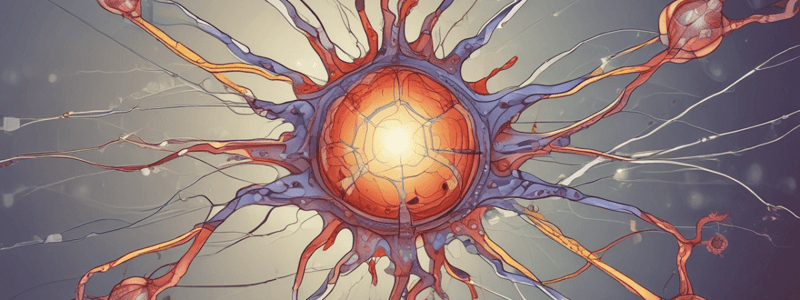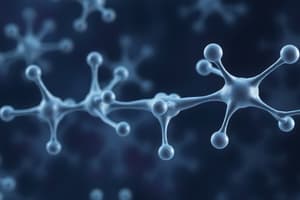Podcast
Questions and Answers
What type of receptors do adrenergic receptors belong to?
What type of receptors do adrenergic receptors belong to?
- Ligand-gated receptors
- Ion-gated receptors
- G protein-coupled receptors (correct)
- Enzyme-linked receptors
Which type of adrenergic receptor mediates vasoconstriction?
Which type of adrenergic receptor mediates vasoconstriction?
- Alpha-1 (α1) receptors (correct)
- Beta-2 (β2) receptors
- Alpha-2 (α2) receptors
- Beta-1 (β1) receptors
What is the effect of beta-2 (β2) receptors on smooth muscle?
What is the effect of beta-2 (β2) receptors on smooth muscle?
- Relaxation of smooth muscle (correct)
- Increase in blood pressure
- Stimulation of smooth muscle contraction
- Decrease in heart rate
What is the primary mechanism of action of adrenergic receptors?
What is the primary mechanism of action of adrenergic receptors?
Which of the following is NOT a physiological process regulated by adrenergic receptors?
Which of the following is NOT a physiological process regulated by adrenergic receptors?
What is the effect of alpha-2 (α2) receptors on blood pressure?
What is the effect of alpha-2 (α2) receptors on blood pressure?
Which type of adrenergic receptor is involved in stimulating glycogenolysis?
Which type of adrenergic receptor is involved in stimulating glycogenolysis?
What is the effect of beta-1 (β1) receptors on heart rate?
What is the effect of beta-1 (β1) receptors on heart rate?
Which disease is associated with the activation of adrenergic receptors?
Which disease is associated with the activation of adrenergic receptors?
What is the ligand that binds to adrenergic receptors?
What is the ligand that binds to adrenergic receptors?
Flashcards are hidden until you start studying
Study Notes
Adrenergic Receptors
Adrenergic receptors are a class of G protein-coupled receptors that respond to the neurotransmitters norepinephrine and epinephrine.
Types of Adrenergic Receptors
There are two main categories of adrenergic receptors:
Alpha Adrenergic Receptors
- alpha-1 (α1) receptors:
- Stimulate smooth muscle contraction
- Increase blood pressure
- Mediate vasoconstriction
- alpha-2 (α2) receptors:
- Inhibit smooth muscle contraction
- Decrease blood pressure
- Mediate vasodilation
Beta Adrenergic Receptors
- beta-1 (β1) receptors:
- Increase heart rate and contractility
- Stimulate renin release
- beta-2 (β2) receptors:
- Relax smooth muscle (bronchodilation)
- Stimulate glycogenolysis
- beta-3 (β3) receptors:
- Stimulate lipolysis
Mechanism of Action
Adrenergic receptors work through a G protein-coupled receptor mechanism:
- Binding of norepinephrine or epinephrine to the receptor
- Activation of the G protein
- Stimulation of downstream signaling pathways (e.g. cAMP, IP3)
- Regulation of various physiological responses (e.g. smooth muscle contraction, heart rate)
Physiological Effects
Adrenergic receptors play a crucial role in various physiological processes, including:
- Regulation of blood pressure and cardiovascular function
- Modulation of smooth muscle tone
- Control of metabolic processes (e.g. glycogenolysis, lipolysis)
- Regulation of respiratory function (e.g. bronchodilation)
Clinical Significance
Adrenergic receptors are involved in various diseases and disorders, including:
- Hypertension
- Heart failure
- Asthma
- Anxiety and depression
- Obesity and metabolic disorders
Adrenergic Receptors
- Respond to the neurotransmitters norepinephrine and epinephrine
- Class of G protein-coupled receptors
Types of Adrenergic Receptors
Alpha Adrenergic Receptors
- alpha-1 (α1) receptors:
- Stimulate smooth muscle contraction
- Increase blood pressure
- Mediate vasoconstriction
- alpha-2 (α2) receptors:
- Inhibit smooth muscle contraction
- Decrease blood pressure
- Mediate vasodilation
Beta Adrenergic Receptors
- beta-1 (β1) receptors:
- Increase heart rate and contractility
- Stimulate renin release
- beta-2 (β2) receptors:
- Relax smooth muscle (bronchodilation)
- Stimulate glycogenolysis
- beta-3 (β3) receptors:
- Stimulate lipolysis
Mechanism of Action
- Binding of norepinephrine or epinephrine to the receptor
- Activation of the G protein
- Stimulation of downstream signaling pathways (e.g. cAMP, IP3)
- Regulation of various physiological responses (e.g. smooth muscle contraction, heart rate)
Physiological Effects
- Regulation of blood pressure and cardiovascular function
- Modulation of smooth muscle tone
- Control of metabolic processes (e.g. glycogenolysis, lipolysis)
- Regulation of respiratory function (e.g. bronchodilation)
Clinical Significance
- Involved in various diseases and disorders, including:
- Hypertension
- Heart failure
- Asthma
- Anxiety and depression
- Obesity and metabolic disorders
Studying That Suits You
Use AI to generate personalized quizzes and flashcards to suit your learning preferences.





